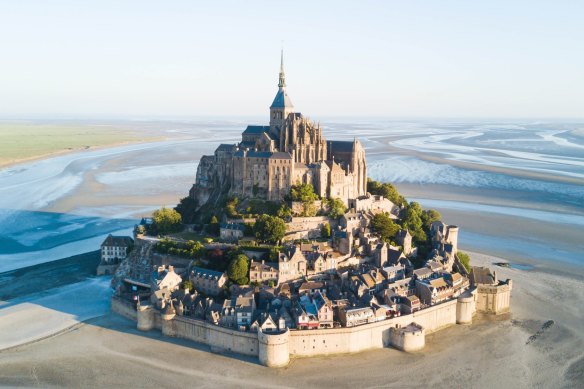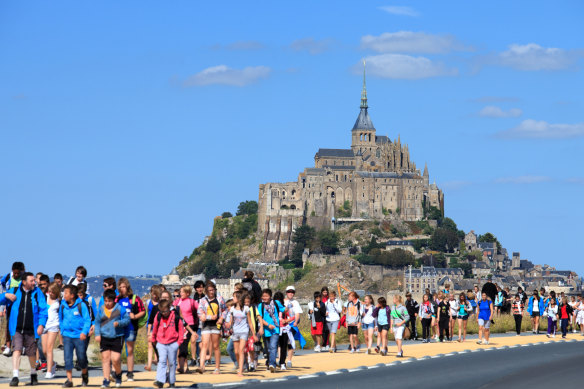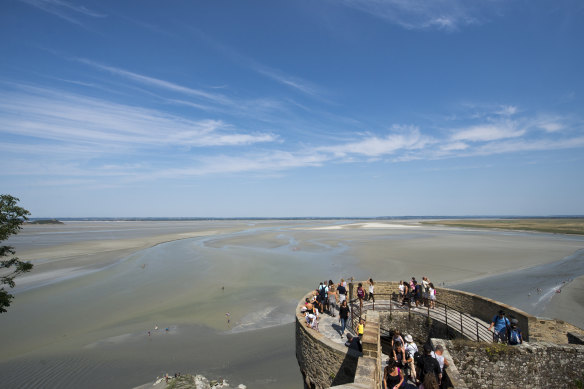The incredible French tidal island worth walking over quicksand for
By Nick Place
If you plan to visit the World Heritage-listed wonder that is the Mont Saint-Michel abbey commune, perched improbably on a tiny island in a bay on the border of Brittany and Normandy in France, you have two options.
You can drive to the car park, catch a shuttle bus to the coast and then stroll across a short bridge to the island.
Or you can hike more than six kilometres across the empty floor of a bay while the tide is out, dodging quicksand, to arrive by foot from Normandy.

Tidal island Mont Saint-Michel.Credit: iStock
The decision was an easy one for me. Barefoot, I stepped off Normandy and joined my guided group in heading off towards the tiny distant triangle that was Mont Saint-Michel. Vital to this part of France is nature, whether wild coasts, big seas and vivid weather, along with the Celtic Saints and deep history. Approaching Mont Saint-Michel across the sands where the sea should be carries a romance and natural power that almost matches the wonder of the island itself.
I’m not the first person to have had this idea. In fact, religious pilgrims have been making this walk from Normandy for a thousand years.
The bay of Mont Saint-Michel is like a swimming pool where the plug is removed before low tide. As for many of the rivers in Brittany the water drains entirely away, leaving only soggy sand and clay for six hours or more. And so, pilgrims would prove their devotion by making the trek, towards the giant abbey built on top of the tiny rock island, the earliest buildings dating back to 966 AD, with additions and repairs ever since.
After the Revolution, the abbey became a jail for a while. Alcatraz with croissants. But then was reclaimed by the monks and nuns of the Monastic Fraternities of Jerusalem, who still live and work there, dressed in distinctive blue.

There’s a bridge leading to the abbey – but where’s the fun in that?Credit: iStock
In 1879, some killjoy built the causeway, making access to the isle from the mainland easier, and in 2014, this became a sophisticated bridge. But where’s the fun in that?
It’s for the quicksand, as well as the history lessons, that you need an accredited guide to attempt the crossing. Local guides know how to spot and avoid threatening patches of sand, while also entertaining groups of walkers by jumping on the quicksand for impromptu demonstrations of how to escape its clutches. We had fun dancing on the trampoline-like sand.
“You can’t die in the quicksand, unless the tide is rising,” guide Anne-Laure Falguieres-Gesbert explains cheerfully. “The problem with quicksand is that once the water comes out from the sand, it hardens like cement. Then the tide comes in.”
Another guide, Romain Pilon, adds that the bay itself is treacherous once the tide starts to rise, with sand banks and rips that are best not to be caught in.
My walk didn’t feel particularly life-threatening on a cloudy, sunny day, with a sea lion sunning itself off to the north and several other guided groups wandering across the bay in the distance. My biggest issue was what brand of Breton cider I’d drink when I arrived.

Views from the abbey of the swirling tidal bay.Credit: iStock
The traditional pilgrim walk leaves from Genêts (Bec d’Andaine) or St Léonard and is a 14- or 15-kilometre round trip, taking the best part of six hours. There’s just time to try and make it to the top of the abbey, depending on crowds, or to poke around the shops and restaurants in the commune’s streets. Or you can just enjoy a leisurely picnic on the sand, before starting the long trek back to the Normandy coast.
Romain said his preferred time for the sandy march is September-October when the light across the bay is soft and the waterbirds are migrating, but tours run most days from April to October.
The guides also lead shorter trips, for those not wanting the full Norman pilgrim experience. There’s even an entirely different 3.5-hour walk, to the island of Tombelaine (“Mont Saint-Michel’s ecological brother,” Romain calls it) in the middle of the bay. There are tours almost every day, with up to 60 people per walk, although smaller groups are more pleasant. Anne-Laure said she caps her groups at a more intimate 25 people. Romain takes up to 30 people, or offers private tours for individuals, or small groups.
DETAILS
Tour
English-speaking guides Romain Pilon and Anne-Laure Falguieres-Gesbert offer walks to Mont Saint-Michel starting from €20 ($33) for adults. See labaiecderomain.fr; guide-nature-baie.com.
The writer travelled at his own expense.
Sign up for the Traveller Deals newsletter
Get exclusive travel deals delivered straight to your inbox. Sign up now.